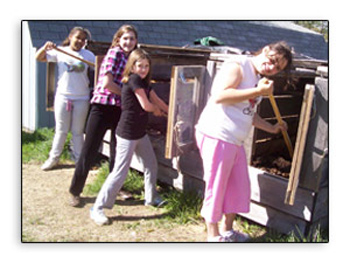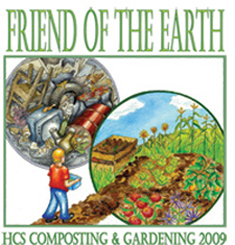The Lessons of Composting
By Karen DiFranza
Whenever I share the story of the Hubbardston Center School composting program, people from all walks of life respond positively: “What a great idea!” “That’s wonderful.” “Wow, how inspiring!” The idea of elementary school children recycling their lunch leftovers to create compost for a schoolyard garden seems to have the universal appeal of a newborn baby or a roly-poly puppy on a leash. What is it about this experience that speaks equally to the corporate manager and the elderly housewife?
There seems to be no doubt in anyone’s mind that some compelling learning is going on here. At a time when schools are pressed into teaching for state-mandated testing, people still intuit the effectiveness of learning with one’s whole self. There is so much scientific information to learn in the composting lesson: microbiology; the plant cycle; nutrients; soil composition; symbiosis; physical reactions. The list is endless. But the special feature of these science lessons is that children (and adults!) can learn them within a meaningful context. We all eat to live, and we all must deal with our garbage on a daily basis. Nothing could be more real in our lives, and nothing could be more productive than managing those resources. When the Hubbardston Center School compost volunteers carry food scraps to the compost bin after lunch, that physical activity helps to integrate the intellectual and technical information they’ve acquired into body and mind. Each day, they layer food scraps with dry organic material, and this reinforces the lessons they have learned about the need for balancing carbon and nitrogen in the composting process. This is the kind of learning that changes us; learning that doesn’t fade away, because it becomes a part of who we are. The “soak it up and squeeze it out for the test” phenomenon holds no water here.
Beyond creating a meaningful context for the integration of scientific information, composting teaches several less quantifiable but important lessons. Hubbardston Center School students know that the alternative to creating valuable compost is to allow these organic materials to become waste which will feed landfills instead of plants and people. Kids are quick to comprehend the wastefulness and toxicity of the landfill. The idea of a hotdog petrified for 50 years in a landfill goes against the grain for them. They understand that there is a serious disconnect in the natural process of the life cycle here (although they do want to know whether it would still taste good with ketchup), and it is disturbing to them.
By contrast, the composting process says, “Yes,” to them. They see the connection between today’s leftovers and tomorrow’s food. They catch on to the idea of worms and microbes eating their leftovers to create healthy soil for growing more food. Their young imaginations grasp the existence of a billion microbes in one teaspoon of compost, and our absolute dependence on these tiniest of creatures gives them new insight into the interconnectedness of all things. If we provide a nurturing habitat for tiny organisms, they will nurture us in turn. It is the basic lesson of environmental science, and it has important spiritual overtones: loving thy neighbor as thyself; doing unto others as you would have done unto yourself; respecting the web of life; seeing the oneness of all living things. These spiritual/ethical concepts set their roots in the soil of interconnectedness, and composting provides an accessible model of how it works.
Understanding our connection to the natural world leads us logically to compassionate behavior. Although our culture does not value or cultivate compassion, this is another concept that children can really “get” when they have an opportunity to observe it in action. If our welfare depends on the wholeness and wellness of other living things, the next logical step is to consider their needs in our actions. When it’s icy, we could put rock salt on the path to the compost bins to facilitate the daily trek. However, the salt will leach into the soil where we plan to have our garden, creating an unfavorable condition for growing vegetables. Despite the inconvenience, we decide against using rock salt. This is the kind of thinking and practice that illustrates for children the importance of acting with compassion and respect. When children live the logic of compassion, it becomes the way in which they relate to the world. We, as adults, need to provide children with opportunities that clearly model the importance of acting compassionately. The simple act of composting is one of those opportunities.

Creating connection and modeling compassion are remarkable achievements for a simple act. Equally impressive is the sense of empowerment that grows in its players. As we haul, layer and turn, we contribute to this miraculous creative process. It is the alchemy of everyday life, transforming garbage into what gardeners often call “black gold”. Of course, if we delve into the science of composting, we learn that it is a truly complex process. But, in our capacity as human participants, the act is simple because it is direct and uncomplicated by technology, large outlays of money, governmental regulation or undue space requirements. With simple hand tools, some basic information and a commitment to a few daily chores, even children can take part in the magic. And when the process is complete, we can use the product, rich, finished compost, to grow food that will nurture us. In a world that continuously removes us from direct participation in the basics of life, composting can give us back a sense of power over our own destinies. It teaches us that we can take part in creating a better world for ourselves and others, one scrap at a time.
The qualitative lessons of composting find expression in the values, behavior and self-esteem of learners, young and old. Such fertile ground nurtures the capacity to make decisions determining social and environmental justice in the 21st century, decisions on which the future of our planet rests.

